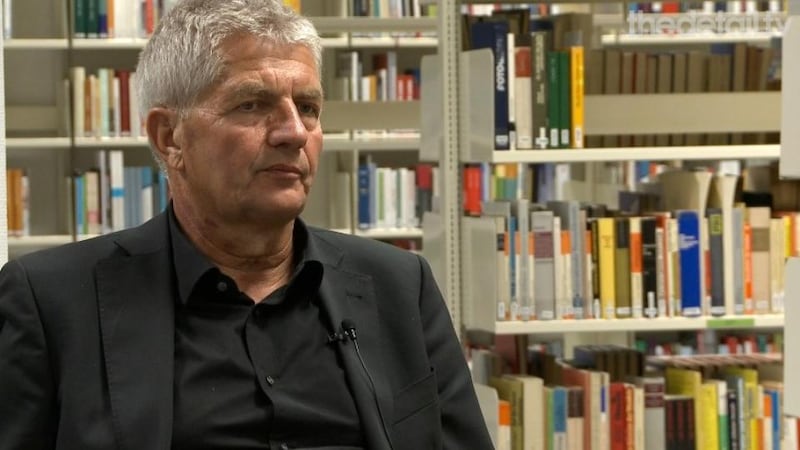Stack up the files left behind by East Germany's feared secret police – the Stasi – and you could fill the road from Newry to Dublin. A quarter of a century after East Germany ceased to exist, the 111km paper trail of its so-called "sword and shield" still exerts an appalling fascination.
After the fall of the Berlin Wall, and before unification, Germany faced a choice with far-reaching consequences: should it open or seal the Stasi archives? Politicians in both Germanys, including then West German interior minister Wolfgang Schäuble, called for the files to be sealed to prevent their contents contaminating unification. After an emotional debate, the first and last democratically elected East German parliament, the Volkskammer, voted in April 1990 to preserve the files with access for all.
Today this decision is seen as a historical gold standard. Just as Northern Ireland politicians are invited to speak around the world on powersharing, Stasi experts and archivists remain in demand to explain how they came to terms with their poisonous past.

'Pain is unavoidable'
Two institutions were crucial in steering this work. The first is the custodian of the files, known by the acronym BStU. The BStU's first head was a pastor and civil rights activist who is now Germany's president, Joachim Gauck. "For people with our history, a pain-free transition to democracy isn't possible, pain is unavoidable," he said in the 1990 Volksammer debate on the files' future.
The Stasi paper trail has proven to be poisonous and compelling. Cases are legion of people discovering how they were spied on by parents, children or siblings. Just as telling, however, are the files compiled by informers who documented with disturbing diligence the banalities of East German life.
Despite the open-file approach, the Stasi files remain a specialist interest. In 1989, only a minority of East Germans went out on the streets to demand democratic reforms. Today only three million of East Germany’s 17 million former citizens have made an application to see their Stasi file.
Stasi's gaze
There are many reasons the majority stayed away. Former informers want their file to remain closed. Others feel they did not come under the Stasi's gaze and do not see the benefit of learning the contrary. Finally, those who accommodated themselves with the East German regime fear this passive acceptance might seem less flattering in harsh Stasi language.
The files remain a goldmine for the German media and, to this day, celebrities are regularly revealed as former Stasi informers. How the Stasi acquired its information and informants – from subtle pressure to outright blackmail – is less frequently discussed. Rarely if ever mentioned in the media today is something hotly discussed in 1990: whether every claim in a Stasi file can and should be taken as gospel.
While the BStU is an important source of raw material, the passage of time and disappearance of eye witnesses make understanding the historical context increasingly important.
A second, lesser-known institution was founded in 1998 to help sort the historical wheat from the fictional Stasi chaff.
With exhibitions, events and publications, the Foundation for Coming to Terms with the SED Dictatorship has so far spent €34 million to examine, discuss and put in context the socialist dictatorship established by East Germany's Socialist Unity Party. With an annual budget of €5.6 million, funded partly by the taxpayer and the SED's own party funds, it keeps the past in the present and ensures facts are kept separate from nostalgia.
In 1990 Germany's debate was about whether to confront past secrets or clear the slate for the future. The argument was decided by agreeing that the two choices were opposite sides of the same coin. How Germany grappled with this moral dilemma – and continues to fund bodies to sift through the past – has universal lessons for all, including Northern Ireland.
But, in practice, the German historical experience is too specific to be transferable. The roots of division of the island of Ireland are far deeper than Germany’s. The decision by East Berlin’s Volkskammer to throw open the Stasi files was made against the backdrop of talks for German unification – and East Germany’s disappearance six months later. Despite official repression of Northern Ireland’s Catholic community, the UK and its institutions – unlike East Germany – remain extant.
Motivation
Roland Jahn, a former civil rights campaigner and current custodian of the Stasi files, is careful about dispensing advice to others. But the motivation behind how Germany dealt with its Stasi legacy is worth closer examination. The motivation was not victor justice, he says, but to allow full access to the facts to encourage reconciliation. "The important thing," he says, "is information."
Journalists from the Detail, an investigative news website based in Belfast, reported from Berlin as part of the Legacy project, a series of reports on issues linked to the Northern Ireland conflict. The Legacy was researched with the support of the North's Community Relations Council and the series is being published in partnership with
The Irish Times
Stasi legacy - by the number s
111km
of shelf space with Stasi files
40 million
or 43km of index cards
15,000
sacks and boxes of shredded and torn files
1.7 million
photos, microfilms and slides
27,600
recordings
The BStU has proces
sed:
6,876,003
applications to view files
2,982,571
private applications
1.8 million
background checks on civil servants for Stasi co-operation
458,000
background checks on politicians and other officials
Since 1998
the
Foundation for Coming to Terms with the SED Dictatorship
has funded
:
2,500 exhibitions
507 events
375 books
100 academic researchers
40,000-item library












